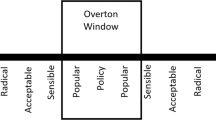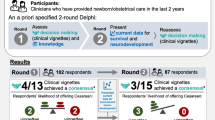Abstract
Objective:
To examine influences on neonatologists' decision-making regarding resuscitation of extremely premature infants.
Study Design:
A mailed survey of Illinois neonatologists evaluated influences on resuscitation. Personal and parentally opposed (that is, acting against parental wishes) gray zones of resuscitation were defined, with the lower limit (LL) the gestational age at or below which resuscitation would be consistently withheld and the upper limit (UL) above which resuscitation was mandatory.
Result:
Among the 85 respondents, LL and UL of the personal and parentally opposed gray zones were median 22 and 25 weeks, respectively. Neonatologists with an UL personal gray zone <25 completed weeks were significantly more fearful of litigation, more likely to have received didactic/continuing medical education teaching, and less likely to always consider parents' opinions in resuscitation decisions. Neonatologists with an UL parentally opposed gray zone <25 completed weeks were more fearful of litigation.
Conclusion:
Neonatologists perceive a ‘gray zone’ of resuscitative practices and should understand that external influences may affect their delivery room resuscitation practices.
This is a preview of subscription content, access via your institution
Access options
Subscribe to this journal
Receive 12 print issues and online access
$259.00 per year
only $21.58 per issue
Buy this article
- Purchase on Springer Link
- Instant access to full article PDF
Prices may be subject to local taxes which are calculated during checkout


Similar content being viewed by others
References
Meadow W, Lee G, Lin K, Lantos J . Changes in mortality for extremely low birth weight infants in the 1990s: implications for treatment decisions and resource use. Pediatrics 2004; 113: 1223–1229.
Markestad T, Kaaresen P, Ronnestad A, Reigstad H, Lossius K, Medbo S et al. Early death, morbidity, and need of treatment among extremely premature infants. Pediatrics 2005; 115: 1289–1298.
Vanhaesebrouck P, Allegaert K, Bottu J, Debauche C, Devlieger H, Docx M et al. The EPIBEL study: outcomes to discharge from hospital for extremely preterm infants in Belgium. Pediatrics 2004; 114: 663–675.
Ballard DW, Li Y, Evans J, Ballard RA, Ubel PA . Fear of litigation may increase resuscitation of infants born near the limits of viability. J Pediatr 2002; 140: 713–718.
Partridge JC, Freeman H, Weiss E, Martinez AM . Delivery room resuscitation decisions for extremely low birthweight infants in California. J Perinatol 2001; 21: 27–33.
Peerzada JM, Richardson DK, Burns JP . Delivery room decision-making at the threshold of viability. J Pediatr 2004; 145: 492–498.
MacDonald H, Committee on Fetus and Newborn. Perinatal care at the threshold of viability. Pediatrics 2002; 110: 1024–1027.
Vohr BR, Wright LL, Dusick AM, Mele L, Verter J, Steichen JJ et al. Neurodevelopmental and functional outcomes of extremely low birth weight infants in the national institute of child health and human development neonatal research network, 1993–1994. Pediatrics 2000; 105: 1216–1226.
Wood NS, Marlow N, Costeloe K, Gibson AT, Wilkinson AR . Neurologic and developmental disability after extremely preterm birth. EPICure study group. N Engl J Med 2000; 343: 378–384.
Child abuse and neglect prevention and treatment program—HHS. Final rule. Fed Regist 1985; 50: 14878–14892.
Kopelman LM, Irons TG, Kopelman AE . Neonatologists judge the ‘Baby Doe’ regulations. N Engl J Med 1988; 318: 677–683.
Born-Alive Infant Protection Act. HR 2175; 2002.
Born-Alive Infants Protection Act of 2001. HR2175 passed March 2002. HHS pledges thorough enforcement of Born-Alive Act. April 27, 2005. Available from: http://www.newsmax.com/archives/articles/2005/4/26/212935.shtml.
Sanders MR, Donohue PK, Oberdorf MA, Rosenkrantz TS, Allen MC . Perceptions of the limit of viability: neonatologists' attitudes toward extremely preterm infants. J Perinatol 1995; 15: 494–502.
Cummings B, McKay K, Hussain N . Neonatologists' opinions regarding resuscitation of extremely premature infants in Connecticut and Rhode Island. Conn Med 2002; 66: 733–738.
Verlato G, Gobber D, Drago D, Chiandetti L, Drigo P . Guidelines for resuscitation in the delivery room of extremely preterm infants. J Child Neurol 2004; 19: 31–34.
American Academy of Pediatrics. Neonatal perinatal member directory. Available from: http://www.aap.org/moc/neoperi/searchindex.htm.
Hosmer D, Lemeshow S (eds.) Applied Logistic Regression. John Wiley & Sons, Inc.: New York, NY, 1989, pp 135–175.
Shewchuk T, Yudkowsky B . Periodic Survey of Fellows No 29: medical Liability Experiences of Pediatricians 1987–1995. American Academy of Pediatrics: Elk Grove Village (IL), 1995.
Catlin A . Physicians' neonatal resuscitation of extremely low-birth-weight preterm infants. Neonatal Netw 2000; 19: 25–32.
Leuthner SR . Decisions regarding resuscitation of the extremely premature infant and models of best interest. J Perinatol 2001; 21: 193–198.
Paris JJ, Schreiber MD, Elias-Jones A . Resuscitation of the preterm infant against parental wishes. Arch Dis Child Fetal Neonatal Ed 2005; 90: F208–F210.
Pinkerton JV, Finnerty JJ, Lombardo PA, Rorty MV, Chapple H, Boyle RJ . Parental rights at the birth of a near-viable infant: conflicting perspectives. Am J Obstet Gynecol 1997; 177: 283–290.
Peerzada JM, Schollin J, Hakansson S . Delivery room decision-making for extremely preterm infants in Sweden. Pediatrics 2006; 117: 1988–1995.
Perinatal care at the threshold of viability. American academy of pediatrics committee on fetus and newborn. American college of obstetricians and gynecologists committee on obstetric practice. Pediatrics 1995; 96: 974–976.
Zupancic JA, Kirpalani H, Barrett J et al. Characterising doctor–parent communication in counseling for impending preterm delivery. Arch Dis Child Fetal Neonatal Ed 2002; 87: F113–F117.
President's Commission for the Study of Ethical Problems in Medicine and Biomedical and Behavioral Research. Deciding to forego life-sustaining treatment: a report on the ethical, medical, and legal issues in treatment decisions. Washington, DC. US Government Printing Office, 1983.
Lemons JA, Bauer CR, Oh W, Korones SB, Papile LA, Stoll BJ et al. Very low birth weight outcomes of the national institute of child health and human development neonatal research network, January 1995 through December 1996. NICHD neonatal research network. Pediatrics 2001; 107: E1.
Sayeed S . Baby Doe Redux? The department of health and human services and the born-alive infants protection act of 2002: a cautionary note on normative neonatal practice. Pediatrics 2005; 116: e576–e585.
Bastek TK, Richardson DK, Zupancic JA, Burns JP . Prenatal consultation practices at the border of viability: a regional survey. Pediatrics 2005; 116: 407–413.
Burns JP, Mitchell C, Griffith JL, Truog RD . End-of-life care in the pediatric intensive care unit: attitudes and practices of pediatric critical care physicians and nurses. Crit Care Med 2001; 29: 658–664.
Cook DJ, Guyatt GH, Jaeschke R et al. Determinants in Canadian health care workers of the decision to withdraw life support from the critically ill. Canadian critical care trials group. JAMA 1995; 273: 703–708.
Andrews B, Lagatta J, Calderelli L, Singh J, Lantos J, Meadow W . ‘Uninformed non-consent’ in the delivery room? Ethical Implications of Poor Predictive Value of Burdensome Outcome in the First Minutes of Life 2006. Available from: E-PAS2006:59:5152.2.
Leuthner S . The medical and legal fallacy of the emergency exception to consent in the delivery room. 2006. Available from E-PAS2006:59:5152.3.
Acknowledgements
Funding for the project was received from the Children's Memorial Hospital Senior Resident Research Fund, Children's Memorial Institute for Education and Research (now, Children's Memorial Research Center), Chicago, IL. We want to thank Kathy Farrow MD, PhD, Joel Frader MD, MA, and Teresa Savage PhD, RN, for their helpful suggestions in the preparation of the manuscript for publication.
Author information
Authors and Affiliations
Corresponding author
Rights and permissions
About this article
Cite this article
Weiss, A., Binns, H., Collins, J. et al. Decision-making in the delivery room: a survey of neonatologists. J Perinatol 27, 754–760 (2007). https://doi.org/10.1038/sj.jp.7211821
Received:
Revised:
Accepted:
Published:
Issue Date:
DOI: https://doi.org/10.1038/sj.jp.7211821
Keywords
This article is cited by
-
Professional ethics: the case of neonatology
Medicine, Health Care and Philosophy (2019)



